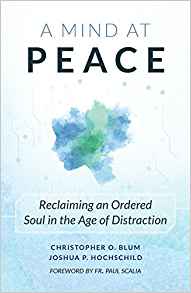This month’s online book roundup includes reading about a future American saint, a children’s Christmas story, and a book to help us with technology in this age of distraction.
 Father Solanus Casey
Father Solanus Casey
by Catherine M. Odell (Our Sunday Visitor)
Ford Field in Detroit is sold out for Nov. 18. No, not for a football game. It’s for the beatification of a former streetcar conductor who became a Franciscan friar in 1897. Fr. Solanus Casey just barely made it to ordination because his grades in the seminary were poor. As a result, he was never given faculties to hear confessions or preach at Mass. Fr. Solanus was made the porter (doorkeeper) of the monastery. As he admitted visitors and routed phone calls, something strange began to happen.
Fr. Solanus’ friendly smile and kindly greetings moved people to open up to him about their troubles. His priestly blessings and promised prayers for them began to have remarkable results. When confronted with these seeming miracles, he would deflect praise with, “These are blessings from God. Thank him.” Within a few years, people were standing in long lines, patiently awaiting their turns to receive counsel and prayers from the man who was not “smart” enough to preach. When he died in 1957, Detroit streets were clogged with 20,000 mourners. Fr. Solanus has continued to answer prayers ever since.
 Kristoph and the First Christmas Tree
Kristoph and the First Christmas Tree
A Legend of St. Boniface
by Claudia Cangilla McAdam, illustrated by Dave Hill (Paraclete Press)
Looking for a Catholic picture-storybook for a child or grandchild? This is it. Legend has it that we have St. Boniface to thank for Christmas trees. He chopped down a mighty oak worshipped by pagan Germans, and a small evergreen tree sprang up from its roots. In this retelling, we see the action through the eyes of Kristoph, an orphan lad who has become the saint’s sidekick. The two journey through the forest, come upon pagan tough guys about to do something gruesome, and rush in to the rescue. It takes all the faith Kristoph can summon to stand by Boniface when they are so outnumbered, but then a miracle happens.
 A Mind at Peace
A Mind at Peace
Reclaiming an Ordered Soul in the Age of Distraction
by Christopher O. Blum and Joshua P. Hochschild (Sophia Institute Press)
Reading this book’s subtitle — Reclaiming an Ordered Soul in the Age of Distraction — I thought to myself, “Yes! Give me some of that!”
Those of us who spent equal parts of our lives before and after the digital revolution have the ability to assess the difference it has made. For one thing, we’ve all acquired a little attention deficit disorder. At least, I certainly have. After years of surfing through short, shallow, yet entertaining blog posts, it’s become harder to settle down and digest a lengthy essay. The thought of kicking back during free time with a classic novel is somewhat less appealing now that tons of colorful content and online shopping deals are waiting for me on any of the three devices that are always within arm’s reach. And yes, I’ve mentioned “wasting time on the internet” frequently in confession these last few years.
Furthermore, the stress brought on by reading heated, fruitless arguments on social media punches a huge hole in my peace of mind. The authors of A Mind at Peace offer us a way to come to terms with technology that goes beyond resolutions (always broken) to “fast” from the internet for so many hours a day or days a week. They don’t waste much time describing how our digital devices can hurt us since we already know that.
Instead they have us examine who we are, what we are called to be, and how that relates to our use of technology. Each chapter describes one positive character trait (for example, being self-aware, resilient, truthful, reasonable, creative), giving examples of how these manifest in everyday life, and how they might specifically apply to our relationship with technology.
Relevant Scripture texts and quotes from saints further bolster their arguments. Each chapter concludes with a few reflection questions that help the reader apply its lessons practically. A Mind at Peace is not a quick fix for our bad internet habits. It’s actually a proposal for a better way of life. Its aim is to adjust our attitudes not just toward technology, but toward ourselves, our fellow humans, and God.

